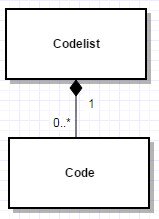Difference between revisions of "Codelist V10"
(→Code ID Conventions) |
(→Code ID Conventions) |
||
| Line 29: | Line 29: | ||
Codelist IDs are given a 'CL_' prefix to distinguish them from other structures. For instance: CL_FREQ, CL_REF_AREA, CL_AGE. | Codelist IDs are given a 'CL_' prefix to distinguish them from other structures. For instance: CL_FREQ, CL_REF_AREA, CL_AGE. | ||
==Code ID Conventions== | ==Code ID Conventions== | ||
| − | Codes can take any legal SDMX [[SDMX ID|ID]]. But there are several conventions | + | Codes can take any legal SDMX [[SDMX ID|ID]]. But there are several conventions that should be taken into account when choosing Code IDs:<br> |
{| | {| | ||
Revision as of 06:54, 17 December 2019
Contents
Overview
An SDMX Codelist is a managed list of classification codes.
| Structure Type | Standard SDMX Structural Metadata Artefact |
| Maintainable | Yes |
| Identifiable | Yes |
| Item Scheme | Yes |
| SDMX Information Model Versions | 1.0, 2.0, 2.1 |
| Concept ID | CODELIST |
SDMX Information Model
Usage
SDMX Codelists are lists of classification codes principally used for defining the set of allowed values for enumerated components in Data Structure Definitions or Metadata Structure Definitions.
Each code is treated as a separated Item so must have an ID and a Name, but can also have an optional Description. While Code IDs are unique within a Codelist, the same Code ID may be safely used in other Codelists. For instance: The code 'A' may be used in a Frequency Codelist to represent 'Annual', but also appear in an Industry Codelist to represent 'Agriculture'.
Conventions
CL_ Codelist ID Prefix
Codelist IDs are given a 'CL_' prefix to distinguish them from other structures. For instance: CL_FREQ, CL_REF_AREA, CL_AGE.
Code ID Conventions
Codes can take any legal SDMX ID. But there are several conventions that should be taken into account when choosing Code IDs:
| Uppercase Code IDs | By convention, Code ID's are in uppercase such as 'ABC'. Lower case Codes are valid (for example 'abc'), but care should be taken in their use to avoid confusion. |
| '_Z' Code | The '_Z' code is conventionally used for the Undefined and Unknown classification. |
| 'TOTAL' Code | The 'TOTAL' code represents the total or sum of the dimension. For a 'country' dimension, series with TOTAL would indicate the sum of observation values for all countries included in the dataset. |
Examples
A Simple Frequency Codelist: CL_FREQ
| Code ID | Code Name |
|---|---|
| A | Annual |
| S | Half-yearly, semester |
| Q | Quarterly |
| M | Monthly |
| W | Weekly |
| D | Daily |
| B | Daily - Business Week |
| N | Minutely |
A Larger Age Codelist: CL_AGE
| Code ID | Code Name |
|---|---|
| Y_LT15 | under 15 years |
| Y_LT5 | under 5 years |
| Y_LT1 | under 1 year |
| Y1 | 1 year |
| Y2 | 2 years |
| Y3 | 3 years |
| Y4 | 4 years |
| Y5-9 | 5 to 9 years |
| Y5 | 5 years |
| Y6 | 6 years |
| Y7 | 7 years |
| Y8 | 8 years |
| Y9 | 9 years |
| Y10-14 | 10 to 14 years |
| Y10 | 10 years |
| Y11 | 11 years |
| Y12 | 12 years |
| Y13 | 13 years |
| Y14 | 14 years |
| Y15-29 | 15 to 29 years |
| Y15-19 | 15 to 19 years |
| Y15 | 15 years |
| Y16 | 16 years |
| Y17 | 17 years |
| Y18 | 18 years |
| Y19 | 19 years |
| Y20-24 | 20 to 24 years |
